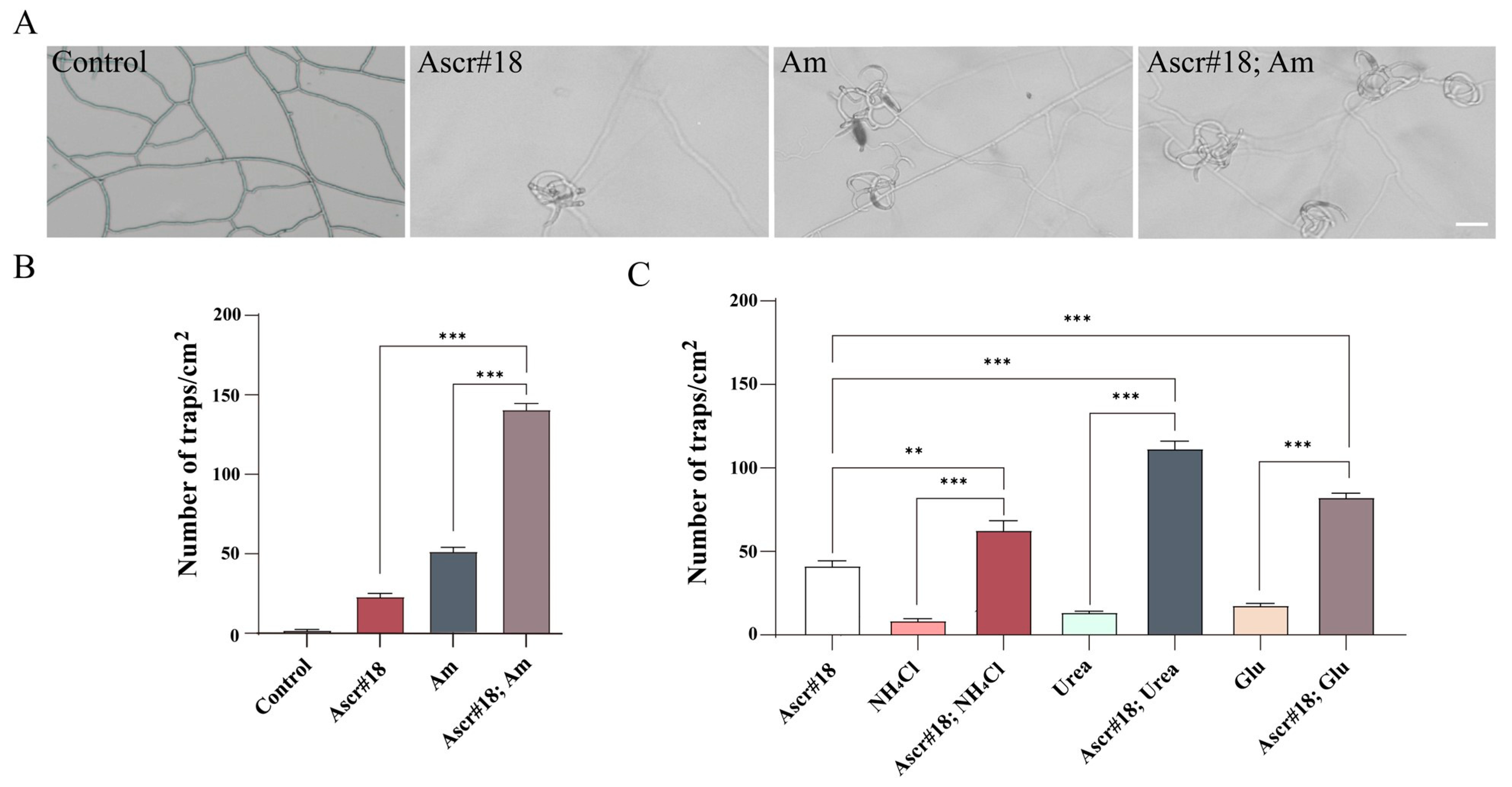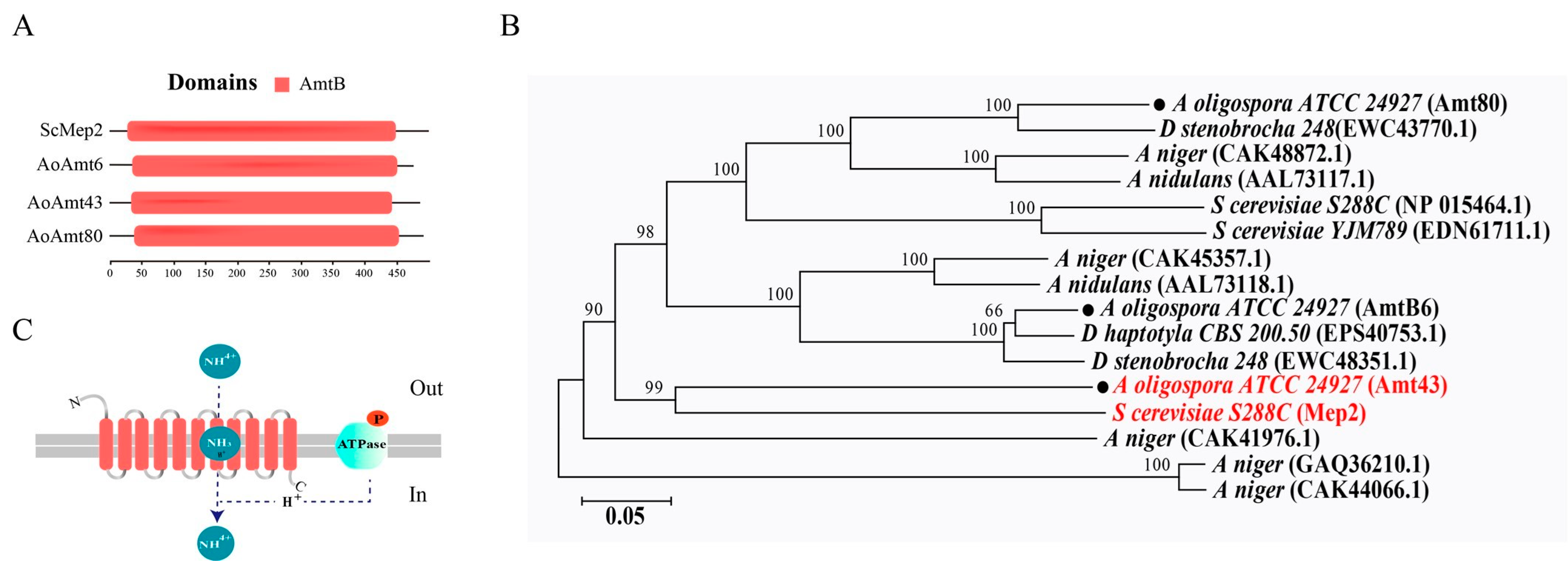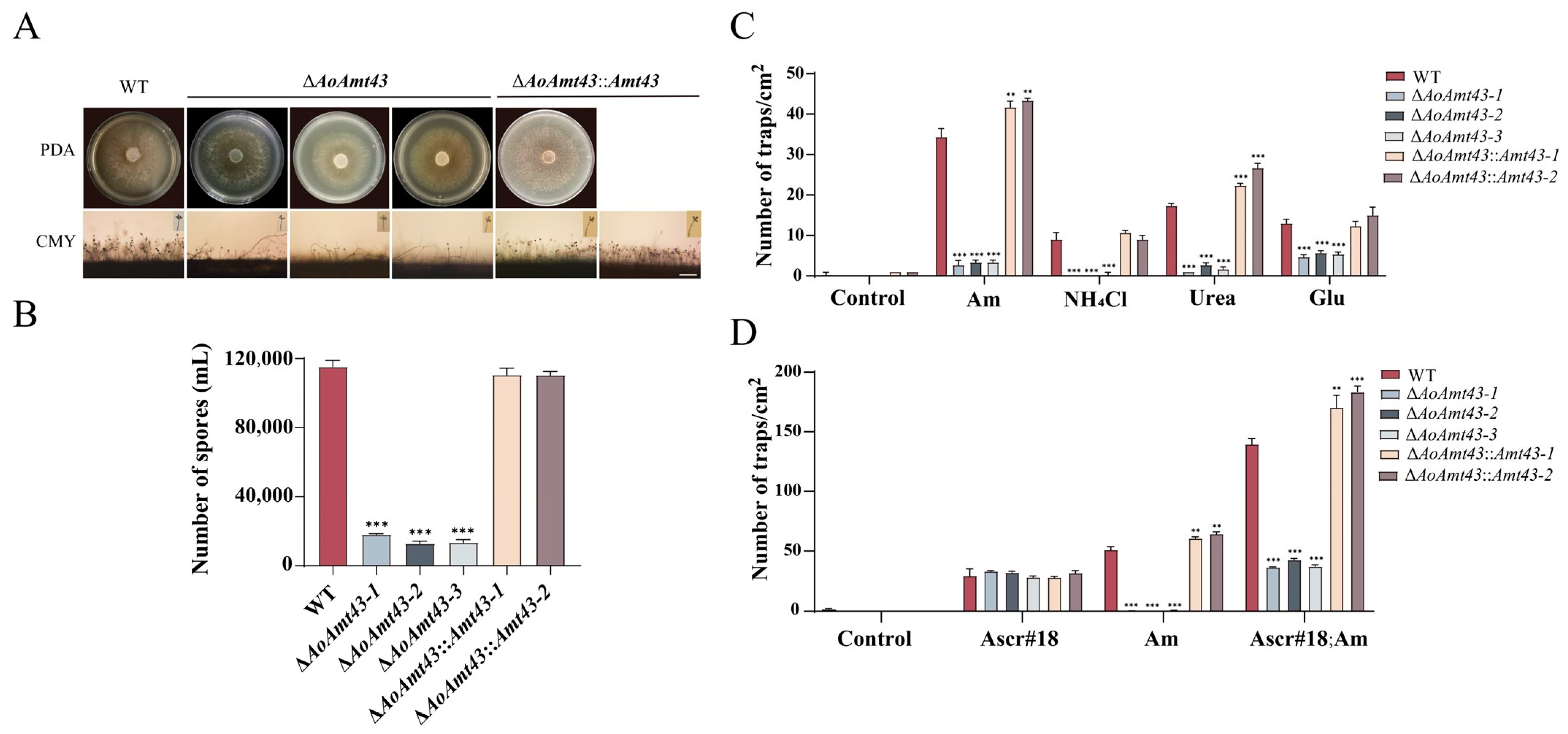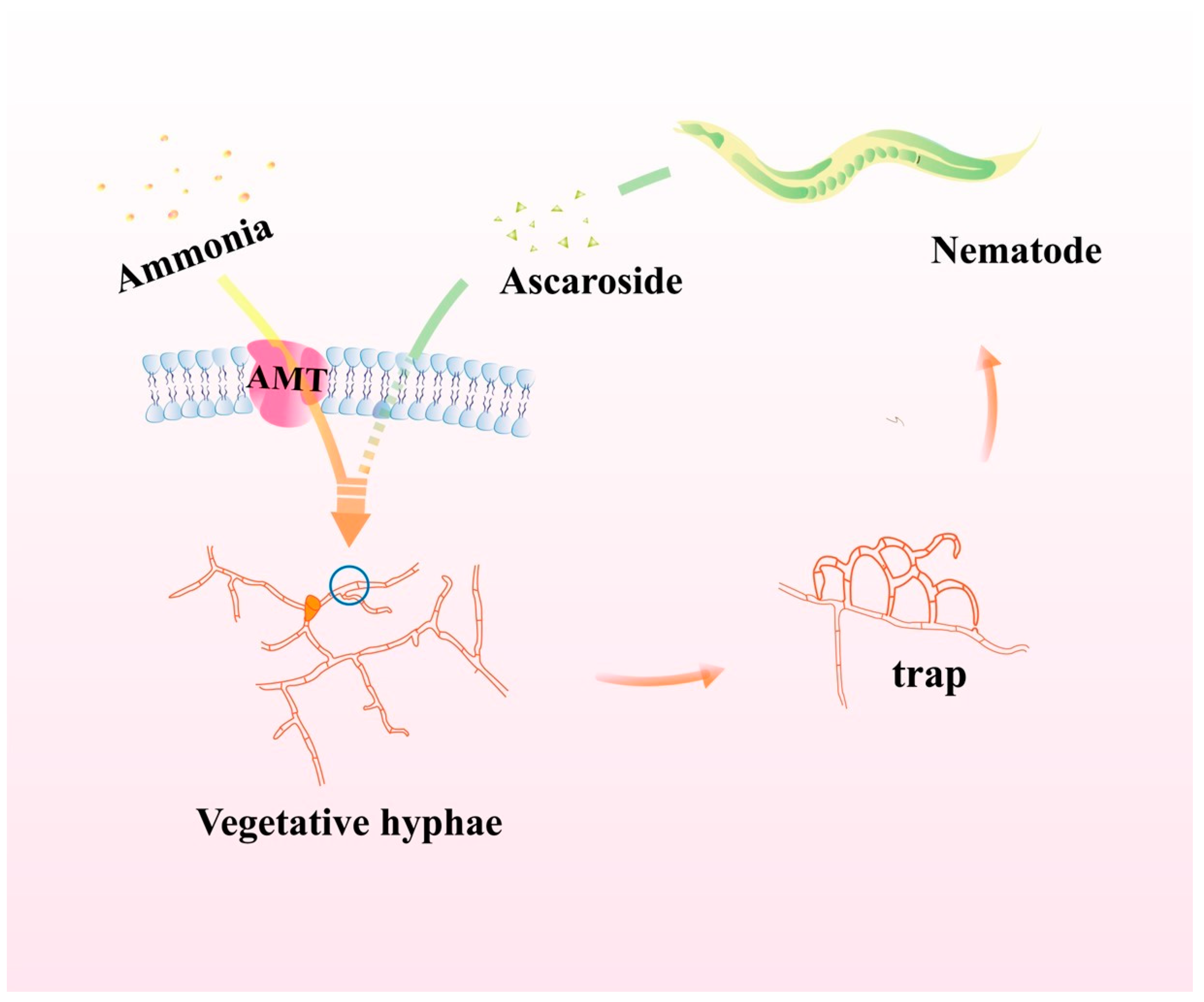Ammonia and Nematode Ascaroside Are Synergistic in Trap Formation in Arthrobotrys oligospora
Abstract
1. Introduction
2. Materials and Methods
2.1. Fungal Strains and Culture Conditions
2.2. Deletion of the Gene Amt43
2.3. Southern Blot Analysis
2.4. Amt43 GFP Labeling and Amt43 Overexpression
2.5. Endocytosis Analysis
2.6. Comparison of Strain Growth
2.7. Formation of Traps and Measurement
2.8. Statistical Analyses
3. Results
3.1. Effect of Am and Ascr#18 on A. oligospora Trap Formation
3.2. Amt43 Is Ammonia Transporter of A. oligospora
3.3. Ascr#18 Interacts with Am in Trap Induction
3.4. Am Can Facilitate Ascr#18 in Inducing A. oligospora to Produce Traps
4. Discussion
Supplementary Materials
Author Contributions
Funding
Institutional Review Board Statement
Informed Consent Statement
Data Availability Statement
Conflicts of Interest
References
- Jiang, X.; Xiang, M.; Liu, X. Nematode-Trapping Fungi. Microbiol. Spectr. 2017, 5. [Google Scholar] [CrossRef]
- Ryder, L.S.; Talbot, N.J. Regulation of appressorium development in pathogenic fungi. Curr. Opin. Plant Biol. 2015, 26, 8–13. [Google Scholar] [CrossRef]
- Wakade, R.S.; Krysan, D.J. The Cbk1-Ace2 axis guides Candida albicans from yeast to hyphae and back again. Curr. Genet. 2021, 67, 461–469. [Google Scholar] [CrossRef]
- Wang, Y.H.; Zheng, X.; Li, G.H.; Wang, X. TORC1 Signaling in Fungi: From Yeasts to Filamentous Fungi. Microorganisms 2023, 11, 218. [Google Scholar] [CrossRef]
- Athanasopoulos, A.; Andre, B.; Sophianopoulou, V.; Gournas, C. Fungal plasma membrane domains. FEMS Microbiol. Rev. 2019, 43, 642–673. [Google Scholar] [CrossRef]
- Gournas, C.; Prevost, M.; Krammer, E.M.; Andre, B. Function and Regulation of Fungal Amino Acid Transporters: Insights from Predicted Structure. In Yeast Membrane Transport; Ramos, J., Sychrova, H., Kschischo, M., Eds.; Advances in Experimental Medicine and Biology; Springer: Berlin/Heidelberg, Germany, 2016; Volume 892, pp. 69–106. [Google Scholar]
- Winkler, F. Amt/MEP/Rh proteins conduct ammonia. Pflug. Arch. 2006, 451, 701–707. [Google Scholar] [CrossRef]
- Klemens, P.A.; Patzke, K.; Deitmer, J.; Spinner, L.; Le Hir, R.; Bellini, C.; Bedu, M.; Chardon, F.; Krapp, A.; Neuhaus, H.E. Overexpression of the vacuolar sugar carrier AtSWEET16 modifies germination, growth, and stress tolerance in Arabidopsis. Plant Physiol. 2013, 163, 1338–1352. [Google Scholar] [CrossRef]
- Kruckeberg, A.L.; Walsh, M.C.; Van Dam, K. How do yeast cells sense glucose? Bioessays 1998, 20, 972–976. [Google Scholar] [CrossRef]
- Wu, A.; Wojtowicz, K.; Savary, S.; Hamon, Y.; Trombik, T. Do ABC transporters regulate plasma membrane organization? Cell. Mol. Biol. Lett. 2020, 25, 17. [Google Scholar] [CrossRef]
- Van Ende, M.; Wijnants, S.; Van Dijck, P. Sugar Sensing and Signaling in Candida albicans and Candida glabrata. Front. Microbiol. 2019, 10, 16. [Google Scholar] [CrossRef]
- Suzuki, A. Propagation strategy of ammonia fungi. Mycoscience 2009, 50, 39–51. [Google Scholar] [CrossRef]
- Andrade, S.L.A.; Einsle, O. The Amt/Mep/Rh family of ammonium transport proteins. Mol. Membr. Biol. 2007, 24, 357–365. [Google Scholar] [CrossRef]
- Garnett, T.; Conn, V.; Kaiser, B.N. Root based approaches to improving nitrogen use efficiency in plants. Plant Cell Environ. 2009, 32, 1272–1283. [Google Scholar] [CrossRef] [PubMed]
- Zidi-Yahiaoui, N.; Ripoche, P.; Le Van Kim, C.; Gane, P.; D’Ambrosio, A.M.; Cartron, J.P.; Colin, Y.; Mouro-Chanteloup, I. Ammonium transport properties of HEK293 cells expressing RhCG mutants: Preliminary analysis of structure/function by site-directed mutagenesis. Transfus. Clin. Biol. 2006, 13, 128–131. [Google Scholar] [CrossRef] [PubMed]
- Marini, A.M.; SoussiBoudekou, S.; Vissers, S.; Andre, B. A family of ammonium transporters in Saccharomyces cerevisiae. Mol. Cell. Biol. 1997, 17, 4282–4293. [Google Scholar] [CrossRef] [PubMed]
- Smith, D.G.; Garcia-Pedrajas, M.D.; Gold, S.E.; Perlin, M.H. Isolation and characterization from pathogenic fungi of genes encoding ammonium permeases and their roles in dimorphism. Mol. Microbiol. 2003, 50, 259–275. [Google Scholar] [CrossRef] [PubMed]
- Monahan, B.J.; Fraser, J.A.; Hynes, M.J.; Davis, M.A. Isolation and characterization of two ammonium permease genes, meaA and mepA, from Aspergillus nidulans. Eukaryot. Cell 2002, 1, 85–94. [Google Scholar] [CrossRef] [PubMed][Green Version]
- Rutherford, J.C.; Lin, X.R.; Nielsen, K.; Heitman, J. Amt2 permease is required to induce ammonium-responsive invasive growth and mating in Cryptococcus neoformans. Eukaryot. Cell 2008, 7, 237–246. [Google Scholar] [CrossRef]
- Biswas, K.; Morschhauser, J. The Mep2p ammonium permease controls nitrogen starvation-induced filamentous growth in Candida albicans. Mol. Microbiol. 2005, 56, 649–669. [Google Scholar] [CrossRef]
- Shnalderman, C.; Miyara, I.; Kobiler, I.; Sherman, A.; Prusky, D. Differential Activation of Ammonium Transporters during the Accumulation of Ammonia by Colletotrichum gloeosporioides and Its Effect on Appressoria Formation and Pathogenicity. Mol. Plant-Microbe Interact. 2013, 26, 345–355. [Google Scholar] [CrossRef]
- McDonald, T.R.; Dietrich, F.S.; Lutzoni, F. Multiple Horizontal Gene Transfers of Ammonium Transporters/Ammonia Permeases from Prokaryotes to Eukaryotes: Toward a New Functional and Evolutionary Classification. Mol. Biol. Evol. 2012, 29, 51–60. [Google Scholar] [CrossRef]
- Severi, E.; Javelle, A.; Merrick, M. The conserved carboxy-terminal region of the ammonia channel AmtB plays a critical role in channel function. Mol. Membr. Biol. 2007, 24, 161–173. [Google Scholar] [CrossRef] [PubMed]
- Thomas, G.H.; Mullins, J.G.L.; Merrick, M. Membrane topology of the Mep/Amt family of ammonium transporters. Mol. Microbiol. 2000, 37, 331–344. [Google Scholar] [CrossRef]
- Neuhauser, B.; Dynowski, M.; Ludewig, U. Switching substrate specificity of AMT/MEP/Rh proteins. Channels 2014, 8, 496–502. [Google Scholar] [CrossRef]
- Lorenz, M.C.; Heitman, J. The MEP2 ammonium permease regulates pseudohyphal differentiation in Saccharomyces cerevisiae. Embo J. 1998, 17, 1236–1247. [Google Scholar] [CrossRef]
- Wang, X.; Li, G.H.; Zou, C.G.; Ji, X.L.; Liu, T.; Zhao, P.J.; Liang, L.M.; Xu, J.P.; An, Z.Q.; Zheng, X.; et al. Bacteria can mobilize nematode-trapping fungi to kill nematodes. Nat. Commun. 2014, 5, 5776. [Google Scholar] [CrossRef]
- Su, H.; Zhao, Y.; Zhou, J.; Feng, H.; Jiang, D.; Zhang, K.Q.; Yang, J. Trapping devices of nematode-trapping fungi: Formation, evolution, and genomic perspectives. Biol. Rev. Camb. Philos. Soc. 2017, 92, 357–368. [Google Scholar] [CrossRef]
- Soliman, M.S.; El-Deriny, M.M.; Ibrahim, D.S.S.; Zakaria, H.; Ahmed, Y. Suppression of root-knot nematode Meloidogyne incognita on tomato plants using the nematode trapping fungus Arthrobotrys oligospora Fresenius. J. Appl. Microbiol. 2021, 131, 2402–2415. [Google Scholar] [CrossRef]
- Pires, D.; Vicente, C.S.L.; Menéndez, E.; Faria, J.M.S.; Rusinque, L.; Camacho, M.J.; Inácio, M.L. The Fight against Plant-Parasitic Nematodes: Current Status of Bacterial and Fungal Biocontrol Agents. Pathogens 2022, 11, 1178. [Google Scholar] [CrossRef]
- Zhang, Y.; Yu, Z.F.; Xu, J.; Zhang, K.Q. Divergence and dispersal of the nematode-trapping fungus Arthrobotrys oligospora from China. Environ. Microbiol. Rep. 2011, 3, 763–773. [Google Scholar] [CrossRef]
- Zhang, F.; Yang, Y.Q.; Zhou, F.P.; Xiao, W.; Boonmee, S.; Yang, X.Y. Morphological and Phylogenetic Characterization of Five Novel Nematode-Trapping Fungi (Orbiliomycetes) from Yunnan, China. J. Fungi 2023, 9, 735. [Google Scholar]
- de Ulzurrun, G.V.D.; Hsueh, Y.P. Predator-prey interactions of nematode-trapping fungi and nematodes: Both sides of the coin. Appl. Microbiol. Biotechnol. 2018, 102, 3939–3949. [Google Scholar]
- Zhou, D.; Zhu, Y.; Bai, N.; Yang, L.; Xie, M.; Yang, J.; Zhu, M.; Zhang, K.-Q.; Yang, J. AoATG5 plays pleiotropic roles in vegetative growth, cell nucleus development, conidiation, and virulence in the nematode-trapping fungus Arthrobotrys oligospora. Sci. China Life Sci. 2022, 65, 412–425. [Google Scholar]
- Hsueh, Y.P.; Mahanti, P.; Schroeder, F.C.; Sternberg, P.W. Nematode-trapping fungi eavesdrop on nematode pheromones. Curr. Biol. 2013, 23, 83–86. [Google Scholar] [PubMed]
- Tan, J.; Zhao, H.; Li, J.; Gong, Y.; Li, X. The Devastating Rice Blast Airborne Pathogen Magnaporthe oryzae-A Review on Genes Studied with Mutant Analysis. Plant Pathog. Fungi 2023, 12, 379. [Google Scholar]
- Zhou, L.; Li, M.; Cui, P.; Tian, M.; Xu, Y.; Zheng, X.; Zhang, K.; Li, G.; Wang, X. Arrestin-Coding Genes Regulate Endocytosis, Sporulation, Pathogenicity, and Stress Resistance in Arthrobotrys oligospora. Front. Cell. Infect. Microbiol. 2022, 12, 754333. [Google Scholar]
- Chen, S.-A.; Lin, H.-C.; Schroeder, F.C.; Hsueh, Y.-P. Prey sensing and response in a nematode-trapping fungus is governed by the MAPK pheromone response pathway. Genetics 2021, 217, iyaa008. [Google Scholar]
- Pérez-Anzúrez, G.; Olmedo-Juárez, A.; von-Son de Fernex, E.; Alonso-Díaz, M.Á.; Delgado-Núñez, E.J.; López-Arellano, M.E.; González-Cortázar, M.; Zamilpa, A.; Ocampo-Gutierrez, A.Y.; Paz-Silva, A.; et al. Arthrobotrys musiformis (Orbiliales) Kills Haemonchus contortus Infective Larvae (Trichostronylidae) through Its Predatory Activity and Its Fungal Culture Filtrates. Pathogens 2022, 11, 1068. [Google Scholar]
- Varlakhanova, N.V.; Tornabene, B.A.; Ford, M.G.J. Feedback regulation of TORC1 by its downstream effectors Npr1 and Par32. Mol. Biol. Cell 2018, 29, 2751–2765. [Google Scholar]
- Boeckstaens, M.; André, B.; Marini, A.M. Distinct transport mechanisms in yeast ammonium transport/sensor proteins of the Mep/Amt/Rh family and impact on filamentation. J. Biol. Chem. 2008, 283, 21362–21370. [Google Scholar]
- Braga, F.R.; de Araújo, J.V. Nematophagous fungi for biological control of gastrointestinal nematodes in domestic animals. Appl. Microbiol. Biotechnol. 2014, 98, 71–82. [Google Scholar]
- Liu, T.; Tian, D.W.; Zou, L.J.; Liu, F.Y.; Can, Q.Y.; Yang, J.K.; Xu, J.P.; Huang, X.W.; Xi, J.Q.; Zhu, M.L.; et al. Quantitative proteomics revealed partial fungistatic mechanism of ammonia against conidial germination of nematode-trapping fungus Arthrobotrys oligospora ATCC24927. Int. J. Biochem. Cell Biol. 2018, 98, 104–112. [Google Scholar]
- Neng-Chang, C.; Sheng-Guang, X.U.; Qi-Tang, W.U.; Jian-Min, Z.; De, B.I.; Wei-Sheng, L.U. Revier of research status, prospects and mechanism of losses of nitrogenous from above-ground plant parts. Acta Phytoecol. Sin. 2009, 33, 414–424. [Google Scholar]
- Williams, L.; Miller, A. Transporters responsible for the uptake and partitioning of nitrogenous solutes. Annu. Rev. Plant Physiol. Plant Mol. Biol. 2001, 52, 659–688. [Google Scholar] [PubMed]
- Gethins, L.; Guneser, O.; Demirkol, A.; Rea, M.C.; Stanton, C.; Ross, R.P.; Yuceer, Y.; Morrissey, J.P. Influence of carbon and nitrogen source on production of volatile fragrance and flavour metabolites by the yeast Kluyveromyces marxianus. Yeast 2015, 32, 67–76. [Google Scholar] [PubMed]
- Marini, A.M.; André, B. In vivo N-glycosylation of the mep2 high-affinity ammonium transporter of Saccharomyces cerevisiae reveals an extracytosolic N-terminus. Mol. Microbiol. 2000, 38, 552–564. [Google Scholar] [PubMed]
- Cheon, Y.; Hwang, H.; Kim, K. Plasticity of pheromone-mediated avoidance behavior in C. elegans. J. Neurogenet. 2020, 34, 420–426. [Google Scholar] [PubMed]
- Miao, Q.; Wang, Z.; Yin, Z.; Liu, X.; Li, R.; Zhang, K.-Q.; Li, J. Nematode-induced trap formation regulated by the histone H3K4 methyltransferase AoSET1 in the nematode-trapping fungus Arthrobotrys oligospora. Sci. China Life Sci. 2023, 1–17. [Google Scholar]
- Yang, B.Y.; Wang, J.; Zheng, X.; Wang, X. Nematode Pheromones: Structures and Functions. Molecules 2023, 28, 2409. [Google Scholar]
- Yang, C.T.; Vidal-Diez de Ulzurrun, G.; Gonçalves, A.P.; Lin, H.C.; Chang, C.W.; Huang, T.Y.; Chen, S.A.; Lai, C.K.; Tsai, I.J.; Schroeder, F.C.; et al. Natural diversity in the predatory behavior facilitates the establishment of a robust model strain for nematode-trapping fungi. Proc. Natl. Acad. Sci. USA 2020, 117, 6762–6770. [Google Scholar]
- Manosalva, P.; Manohar, M.; von Reuss, S.H.; Chen, S.; Koch, A.; Kaplan, F.; Choe, A.; Micikas, R.J.; Wang, X.; Kogel, K.H.; et al. Conserved nematode signalling molecules elicit plant defenses and pathogen resistance. Nat. Commun. 2015, 6, 7795. [Google Scholar] [PubMed]





Disclaimer/Publisher’s Note: The statements, opinions and data contained in all publications are solely those of the individual author(s) and contributor(s) and not of MDPI and/or the editor(s). MDPI and/or the editor(s) disclaim responsibility for any injury to people or property resulting from any ideas, methods, instructions or products referred to in the content. |
© 2023 by the authors. Licensee MDPI, Basel, Switzerland. This article is an open access article distributed under the terms and conditions of the Creative Commons Attribution (CC BY) license (https://creativecommons.org/licenses/by/4.0/).
Share and Cite
Huang, J.; Zheng, X.; Tian, M.; Zhang, K. Ammonia and Nematode Ascaroside Are Synergistic in Trap Formation in Arthrobotrys oligospora. Pathogens 2023, 12, 1114. https://doi.org/10.3390/pathogens12091114
Huang J, Zheng X, Tian M, Zhang K. Ammonia and Nematode Ascaroside Are Synergistic in Trap Formation in Arthrobotrys oligospora. Pathogens. 2023; 12(9):1114. https://doi.org/10.3390/pathogens12091114
Chicago/Turabian StyleHuang, Jinrong, Xi Zheng, Mengqing Tian, and Keqin Zhang. 2023. "Ammonia and Nematode Ascaroside Are Synergistic in Trap Formation in Arthrobotrys oligospora" Pathogens 12, no. 9: 1114. https://doi.org/10.3390/pathogens12091114
APA StyleHuang, J., Zheng, X., Tian, M., & Zhang, K. (2023). Ammonia and Nematode Ascaroside Are Synergistic in Trap Formation in Arthrobotrys oligospora. Pathogens, 12(9), 1114. https://doi.org/10.3390/pathogens12091114





